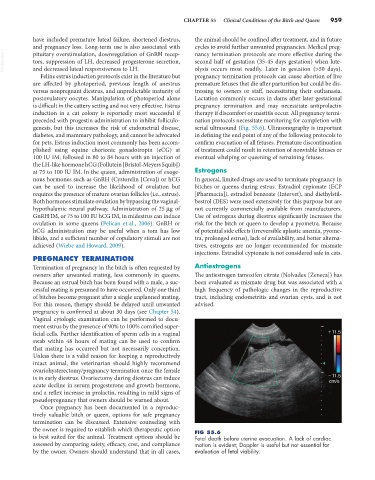Page 987 - Small Animal Internal Medicine, 6th Edition
P. 987
CHAPTER 55 Clinical Conditions of the Bitch and Queen 959
have included premature luteal failure, shortened diestrus, the animal should be confined after treatment, and in future
and pregnancy loss. Long-term use is also associated with cycles to avoid further unwanted pregnancies. Medical preg-
VetBooks.ir pituitary overstimulation, downregulation of GnRH recep- nancy termination protocols are more effective during the
second half of gestation (35-45 days gestation) when lute-
tors, suppression of LH, decreased progesterone secretion,
and decreased luteal responsiveness to LH.
pregnancy termination protocols can cause abortion of live
Feline estrus induction protocols exist in the literature but olysis occurs most readily. Later in gestation (>50 days),
are affected by photoperiod, previous length of anestrus premature fetuses that die after parturition but could be dis-
versus nonpregnant diestrus, and unpredictable maturity of tressing to owners or staff, necessitating their euthanasia.
postovulatory oocytes. Manipulation of photoperiod alone Lactation commonly occurs in dams after later gestational
is difficult in the cattery setting and not very effective. Estrus pregnancy termination and may necessitate antiprolactin
induction in a cat colony is reportedly most successful if therapy if discomfort or mastitis occur. All pregnancy termi-
preceded with progestin administration to inhibit folliculo- nation protocols necessitate monitoring for completion with
genesis, but this increases the risk of endometrial disease, serial ultrasound (Fig. 55.6). Ultrasonography is important
diabetes, and mammary pathology, and cannot be advocated in defining the end point of any of the following protocols to
for pets. Estrus induction most commonly has been accom- confirm evacuation of all fetuses. Premature discontinuation
plished using equine chorionic gonadotropin (eCG) at of treatment could result in retention of nonviable fetuses or
100 IU IM, followed in 80 to 84 hours with an injection of eventual whelping or queening of remaining fetuses.
the LH-like hormone hCG (Follutein [Bristol-Meyers Squib])
at 75 to 100 IU IM. In the queen, administration of exoge- Estrogens
nous hormones such as GnRH (Cystorelin [Ceva]) or hCG In general, limited drugs are used to terminate pregnancy in
can be used to increase the likelihood of ovulation but bitches or queens during estrus. Estradiol cypionate (ECP
requires the presence of mature ovarian follicles (i.e., estrus). [Pharmacia]), estradiol benzoate (Intervet), and diethylstil-
Both hormones stimulate ovulation by bypassing the vaginal- bestrol (DES) were used extensively for this purpose but are
hypothalamic neural pathway. Administration of 25 µg of not currently commercially available from manufacturers.
GnRH IM, or 75 to 100 IU hCG IM, in midestrus can induce Use of estrogens during diestrus significantly increases the
ovulation in some queens (Pelican et al., 2006). GnRH or risk for the bitch or queen to develop a pyometra. Because
hCG administration may be useful when a tom has low of potential side effects (irreversible aplastic anemia, pyome-
libido, and a sufficient number of copulatory stimuli are not tra, prolonged estrus), lack of availability, and better alterna-
achieved (Wiebe and Howard, 2009). tives, estrogens are no longer recommended for mismate
injections. Estradiol cypionate is not considered safe in cats.
PREGNANCY TERMINATION
Termination of pregnancy in the bitch is often requested by Antiestrogens
owners after unwanted mating, less commonly in queens. The antiestrogen tamoxifen citrate (Nolvadex [Zeneca]) has
Because an estrual bitch has been found with a male, a suc- been evaluated as mismate drug but was associated with a
cessful mating is presumed to have occurred. Only one third high frequency of pathologic changes in the reproductive
of bitches become pregnant after a single unplanned mating. tract, including endometritis and ovarian cysts, and is not
For this reason, therapy should be delayed until unwanted advised.
pregnancy is confirmed at about 30 days (see Chapter 54).
Vaginal cytologic examination can be performed to docu-
ment estrus by the presence of 90% to 100% cornified super-
ficial cells. Further identification of sperm cells in a vaginal 11.5
swab within 48 hours of mating can be used to confirm
that mating has occurred but not necessarily conception.
Unless there is a valid reason for keeping a reproductively
intact animal, the veterinarian should highly recommend
ovariohysterectomy/pregnancy termination once the female
is in early diestrus. Ovariectomy during diestrus can induce 11.5
cm/s
acute decline in serum progesterone and growth hormone,
and a reflex increase in prolactin, resulting in mild signs of
pseudopregnancy that owners should be warned about.
Once pregnancy has been documented in a reproduc-
tively valuable bitch or queen, options for safe pregnancy
termination can be discussed. Extensive counseling with
the owner is required to establish which therapeutic option FIG 55.6
is best suited for the animal. Treatment options should be Fetal death before uterine evacuation. A lack of cardiac
assessed by comparing safety, efficacy, cost, and compliance motion is evident; Doppler is useful but not essential for
by the owner. Owners should understand that in all cases, evaluation of fetal viability.

